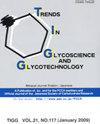蛋白<i>C</i>-甘露糖基化在生理和病理中的功能
IF 0.2
4区 生物学
Q4 BIOCHEMISTRY & MOLECULAR BIOLOGY
引用次数: 0
摘要
蛋白质c -甘露糖基化是一种独特的蛋白质糖基化,其中单个α-甘露糖通过C-C键连接到色氨酸(Trp)的吲哚C2。Trp-x-x-Trp (WxxW)序列,其第一个Trp残基可能是c -甘露糖基化的,构成了这种罕见糖基化修饰的共识基序。Dpy-19是秀丽隐杆线虫中编码c -甘露糖基转移酶的基因。DPY19L1和DPY19L3后来被证实是哺乳动物c -甘露糖基转移酶。共识基序可以在血小板反应蛋白1型重复序列和细胞因子受体I型家族以及许多其他蛋白质中发现,最近的研究表明c -甘露糖基化在底物蛋白的折叠、分类和/或分泌中起关键作用。我们成功合成了c -甘露糖基化含Trp-Ser-Pro-Trp (WSPW)肽。由于在我们的研究中使用了这些肽,我们提出c -甘露糖基化除了有助于底物蛋白的折叠和稳定性外,还可能具有生物学功能。在这篇综述中,我们根据我们最近的发现讨论了c -甘露糖基化在生理和病理中的生物学作用。本文章由计算机程序翻译,如有差异,请以英文原文为准。
Functions of Protein <i>C</i>-Mannosylation in Physiology and Pathology
Protein C-mannosylation is a unique type of protein glycosylation in which a single α-mannose is attached to the indole C2 of tryptophan (Trp) through a C–C bond. The Trp-x-x-Trp (WxxW) sequences, whose first Trp residue may be C-mannosylated, constitute the consensus motifs of this rare glycosylation modification. Dpy-19 was recognized as a gene encoding C-mannosyltransferase in Caenorhabditis elegans. DPY19L1 and DPY19L3 were later confirmed as mammalian C-mannosyltransferases. The consensus motif can be found in the thrombospondin type 1 repeat and cytokine receptor type I families as well as in many other proteins, and recent studies suggest critical roles of C-mannosylation in the folding, sorting, and/or secretion of the substrate proteins. We successfully synthesized C-mannosylated Trp-containing Trp-Ser-Pro-Trp (WSPW) peptides. As a result of using these peptides in our investigations, we proposed that C-mannosylation may have biological functions in addition to contributing to the folding and stability of the substrate proteins. In this mini-review, we discuss the biological roles of C-mannosylation in physiology and pathology as based on our recent findings.
求助全文
通过发布文献求助,成功后即可免费获取论文全文。
去求助
来源期刊

Trends in Glycoscience and Glycotechnology
生物-生化与分子生物学
CiteScore
0.40
自引率
0.00%
发文量
50
审稿时长
>12 weeks
期刊介绍:
TIGG is an international, bilingual journal covering glycoscience and glycotechnology and issued bimonthly since 1989. Since then editors are elected from academia and companies who agree to participate in a volunteer basis for the duration of four years.
TIGG is an official journal of the Japanese Society of Carbohydrate Research.
The journal covers the following categories.
MINIREVIEWS describe recent progress in the fields of glycoscience and glycotechnology. Suggestions are always welcome in the form of a one-page synopsis (double spaced) addressed to the editor-in-chief.
GLYCOTOPICS are short commentaries on the latest papers describing outstanding findings with background.
GLYCODEBUTS introduce distinguished PhD theses or outstanding works of young scientists over the world in glycosciences and glycotechnologies.
GLYCOFORUM is for our readers who wish to submit comments on scientific or social matters related to glycoscience and glycotechnology.
LETTERS TO TIGG are for readers who wish to discuss contributions appearing in TIGG or matters related to FCCA.
 求助内容:
求助内容: 应助结果提醒方式:
应助结果提醒方式:


